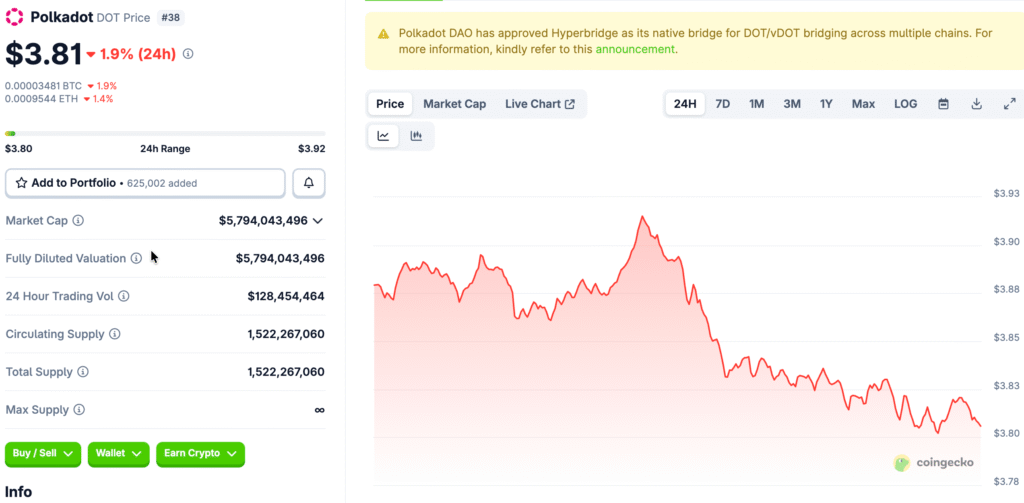Polkadot Community Approves Historic 2.1B Token Supply Cap Proposal
The governance community of Polkadot has agreed to a strong proposal to limit the total number of tokens to 2.1 billion. With 81% of participating token holders voting in favor, the referendum known as 1710 passed. This historic choice replaces the old model of issuing unlimited DOT tokens, which created 120 million new tokens each year. This raised concerns about inflation and keeping the long-term value of the tokens.
The new framework shows that Polkadot’s economic model is changing in a big way. The network wants to follow deflationary principles that focus on scarcity and long-term sustainability by setting a clear limit on the amount of supply. This is similar to what big blockchain networks do to boost investor confidence and keep token value stable over time.

Transition to a Two-Year Inflation Schedule
Polkadot will put in place a structured two-year inflation schedule that slowly moves the network toward the new capped supply, thanks to the changes that were approved. This phased approach lets developers, validators, and token holders get used to the changing issuance dynamics without sudden changes in the market. It is a fair compromise between incentives to grow and pressure to deflate.
Polkadot officials say that by 2040, the capped model will have about 1.91 billion tokens in circulation. The old system, which allowed for unlimited minting, would have made more than 3.4 billion tokens by this time. This big difference shows how the community’s decision about governance will affect things in the long run.
Market Responds to Tokenomics Reform
After the announcement, DOT’s price dropped by 2.2% in 24 hours, bringing it down to $4.32. The token is still up 9.8% over the past week, even though it has dropped in value in the short term. This shows that the market is generally optimistic about the reforms. It seems that investors are weighing short-term reactions against the possible long-term benefits of lowering token emissions.
People in the market think that the new supply model will slowly make things more scarce in the ecosystem. This could make the token more valuable to both retail and institutional investors, especially since the market is becoming more favorable to deflationary assets.
Recommended Article: Remittix Emerges as Top Crypto Pick Over LTC, DOT and PEPE
Governance Through OpenGov Empowers the Community
Polkadot’s OpenGov framework, a decentralized governance system that started in 2023, made the decision to limit supply possible. OpenGov lets token holders suggest, vote on, or delegate key protocol decisions. This makes sure that economic reforms are based on the will of the whole community instead of being controlled by a small group of people.
This way of governing has become a key part of Polkadot’s ecosystem, showing how DAOs can work together to make big changes to the economy in a clear way. Referendum 1710 is a clear example of how the community can change the future of a big blockchain network.
Deflationary Model Signals New Economic Era
Tokenomics reforms are meant to make the economy more stable and appealing for people who are part of the ecosystem. Polkadot is one of many networks that are switching from inflationary to capped issuance to make sure that the network stays stable over the long term.
Lower emission rates are likely to encourage people to hold onto their investments, boost market confidence, and bring in new capital. This change in strategy shows that Polkadot wants to stay competitive in a blockchain economy that is growing quickly.
Implications for Long-Term Holders and Developers
For people who hold tokens for a long time, the capped supply could help prices stay stable and give them a chance to go up, which would be in line with the network’s growth path. Issuance schedules that are easy to predict may help developers and validators plan rewards and costs more accurately.
These changes could make the on-chain economy healthier by balancing the reasons people want to participate with ways to keep things scarce. As the new system is put into place, stakeholders will keep a close eye on how it affects staking dynamics, participation in governance, and the growth of the ecosystem.
A Change in Polkadot’s Economic Future
The decision to limit the supply of Polkadot tokens to 2.1 billion is a major change in the way the tokens work. The network is setting itself up to be more resilient and competitive by accepting scarcity and giving power to governance. This change shows that Polkadot is getting older and more mature, and it aligns economic incentives with long-term growth goals.
As implementation moves forward, the effects of this important decision will likely affect DOT’s market trajectory for years to come, affecting how investors act, how developers work, and the blockchain landscape as a whole.























